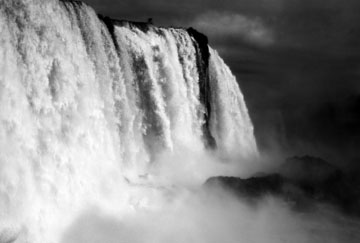Waterfalls often make interesting images not least because human beings tend to be drawn to water - particularly when it is moving. It is therefore worthwhile trying to capture the movement of the falling water in an otherwise motionless landscape. However, also remember that there are other rewarding ways to capture the beauty of waterfalls, not least freezing every drop of water - but more of that later.
 To capture a waterfall with silky smooth flowing water it is best to start with a shutter speed in the region of one or two seconds. It is therefore necessary to set the camera up on a stable tripod and attach a remote release so that the camera will not be moved when the shutter is released. Select shutter-priority mode and choose a shutter speed of one or two seconds. Not what aperture is required for optimum exposure and if necessary reduce the ISO rating or attach a neutral density filter. Polarizing filters can also be used to reduce the light entering the lens and may be beneficial in this application because they also eliminate some of the unwanted reflections from the water.
To capture a waterfall with silky smooth flowing water it is best to start with a shutter speed in the region of one or two seconds. It is therefore necessary to set the camera up on a stable tripod and attach a remote release so that the camera will not be moved when the shutter is released. Select shutter-priority mode and choose a shutter speed of one or two seconds. Not what aperture is required for optimum exposure and if necessary reduce the ISO rating or attach a neutral density filter. Polarizing filters can also be used to reduce the light entering the lens and may be beneficial in this application because they also eliminate some of the unwanted reflections from the water.
Setting the optimum exposure may not be easy, so try a bit of bracketing. The water is likely to be much brighter than the surrounding rocks or landscape, so exposure setting is dependent to some extent upon how much of the frame is occupied by the water itself. Don't be afraid to go close in the the water fall (provided it is safe to do so). Wonderful shots can be obtained by almost filling the frame with moving water. Dramatic light is also a huge plus, although not always easy to find. The shot shown on the left was taken as a storm approached, and the dark sky added a great deal to the image.
Although flowing water does make good images, always remain open to other ideas. One such possibility is to use a very high shutter speed to capture every single sparkling droplet with complete clarity. A shutter speed of 1/1000 sec or higher may be necessary to do this, depending on the speed of the falling water. The use of a high shutter speed will dictate the use of a wide aperture, perhaps f/2 or f/2.8, and this in turn implies reduced depth of field. With this approach it may therefore be necessary to consider which parts of the image are to be rendered sharp and which areas may be allowed to go soft.






